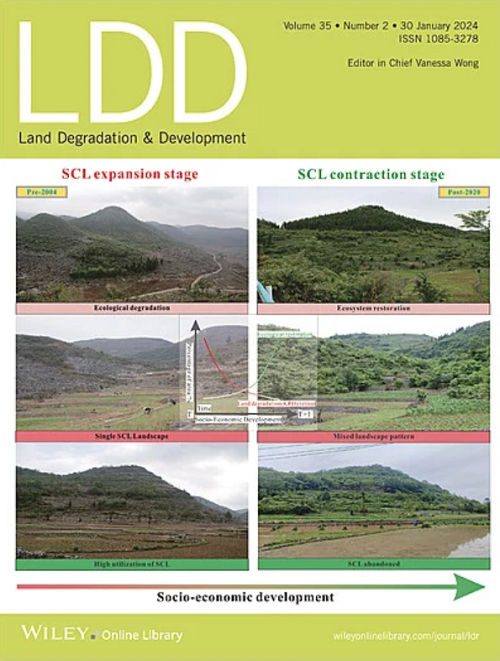Spatiotemporal Response Relationships Between Changes in Water Conservation Service and Landscape Pattern in Zoige Plateau, China
IF 3.6
2区 农林科学
Q2 ENVIRONMENTAL SCIENCES
引用次数: 0
Abstract
Understanding the link between landscape pattern and water conservation service (WCS) is crucial for effective water resource conservation and landscape planning. However, the impact of landscape configuration on WCS remains unclear. This study explored the spatiotemporal relationships between WCS and landscape pattern in the Zoige Plateau (ZP), a vital waterhead of the yellow river, from 1990 to 2020. The results showed that woodland and high‐coverage grassland exhibited the highest WCS capacity and contributed the greatest to total WCS, suggesting the importance of protecting coverage and area of woodland and grassland. From 1990 to 2020, the areas of high‐ and medium‐coverage grasslands significantly decreased, implying adverse effects of landscape composition changes on ZP's WCS during the past few decades. The effects of landscape configuration metrics on WCS exhibited significant variability across years, climate scenarios and regions, highlighting the significant role of climatic and underlying surface. Under realistic climatic scenarios, for greater WCS, in most parts of the western and northern ZP, which negatively correlated with aggregation index, patch density, and mean fractal dimension index but positively correlated with shannon's diversity index, it is better to increase the proportion of large patches, reduce landscape fragmentation, and maintain diverse patch types. Conversely, in southeastern part of the central ZP, where WCS showed an opposite correlation with the aforementioned metrics, maintaining simpler patch type diversity and higher landscape connectivity may be useful. These findings provided important insights for identifying sensitive areas where landscape pattern changes affect WCS and optimizing landscapes to sustain ZP's WCS.中国卓资高原节水服务变化与景观格局的时空响应关系
了解景观格局与节水服务(WCS)之间的联系对于有效的水资源保护和景观规划至关重要。然而,景观格局对 WCS 的影响仍不清楚。本研究探讨了 1990-2020 年黄河重要水源地--卓资高原(ZP)的水保服务与景观格局之间的时空关系。结果表明,林地和高覆盖度草地的消减能力最高,对总消减量的贡献最大,表明保护林地和草地覆盖率和面积的重要性。从 1990 年到 2020 年,高覆盖率和中等覆盖率草地的面积明显减少,这意味着过去几十年中景观组成的变化对 ZP 的 WCS 产生了不利影响。景观配置指标对WCS的影响在不同年份、不同气候情景和不同地区之间表现出显著的差异性,凸显了气候和地表的重要作用。在现实的气候情景下,为了获得更高的WCS,在ZP西部和北部的大部分地区(与聚集指数、斑块密度和平均分形维度指数呈负相关,但与香农多样性指数呈正相关),最好增加大斑块的比例,减少景观破碎化,并保持斑块类型的多样性。相反,在中部 ZP 的东南部,WCS 与上述指标呈现相反的相关性,保持较简单的斑块类型多样性和较高的景观连通性可能是有用的。这些发现为识别景观格局变化影响 WCS 的敏感区域以及优化景观以维持 ZP 的 WCS 提供了重要启示。
本文章由计算机程序翻译,如有差异,请以英文原文为准。
求助全文
约1分钟内获得全文
求助全文
来源期刊

Land Degradation & Development
农林科学-环境科学
CiteScore
7.70
自引率
8.50%
发文量
379
审稿时长
5.5 months
期刊介绍:
Land Degradation & Development is an international journal which seeks to promote rational study of the recognition, monitoring, control and rehabilitation of degradation in terrestrial environments. The journal focuses on:
- what land degradation is;
- what causes land degradation;
- the impacts of land degradation
- the scale of land degradation;
- the history, current status or future trends of land degradation;
- avoidance, mitigation and control of land degradation;
- remedial actions to rehabilitate or restore degraded land;
- sustainable land management.
 求助内容:
求助内容: 应助结果提醒方式:
应助结果提醒方式:


